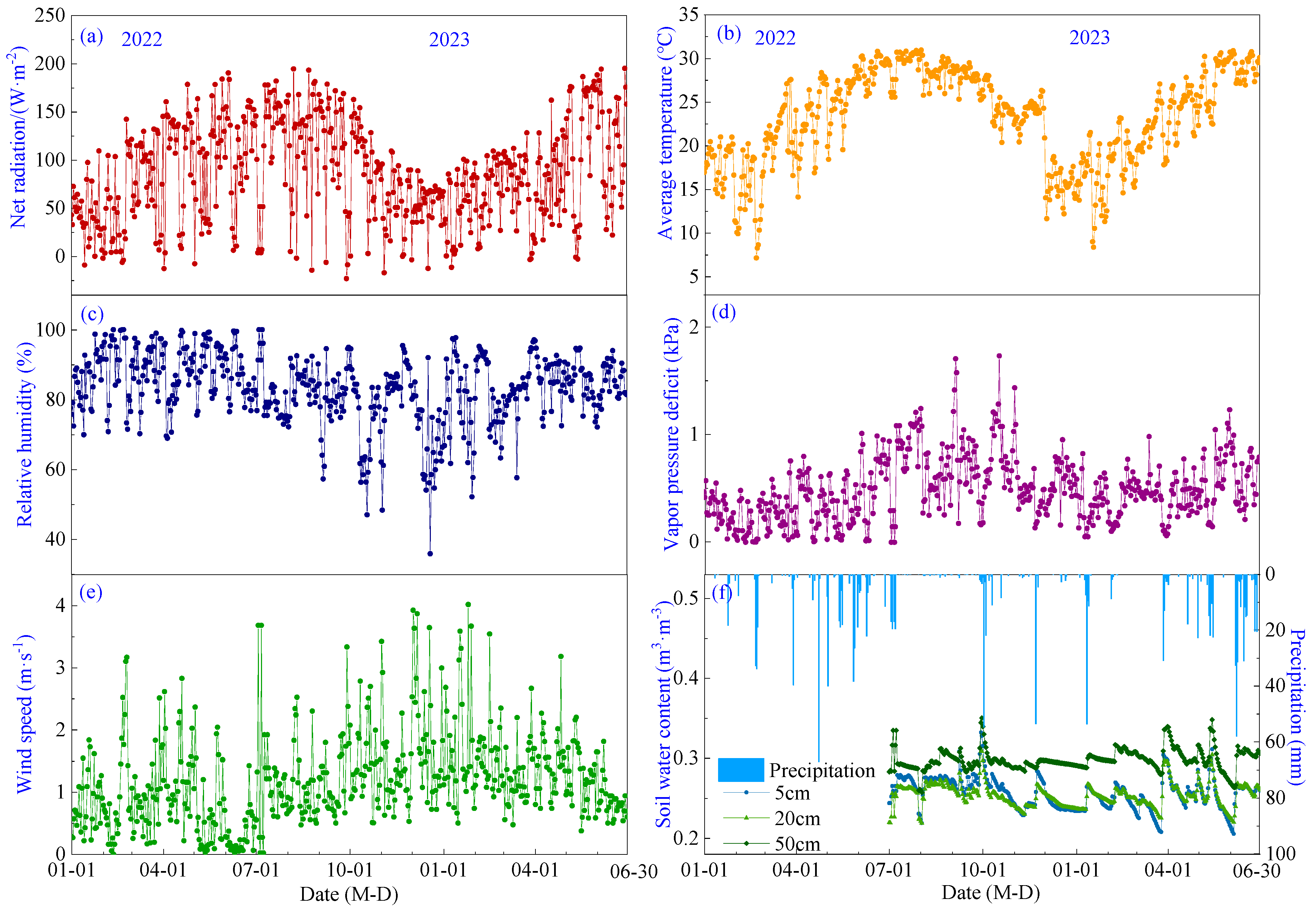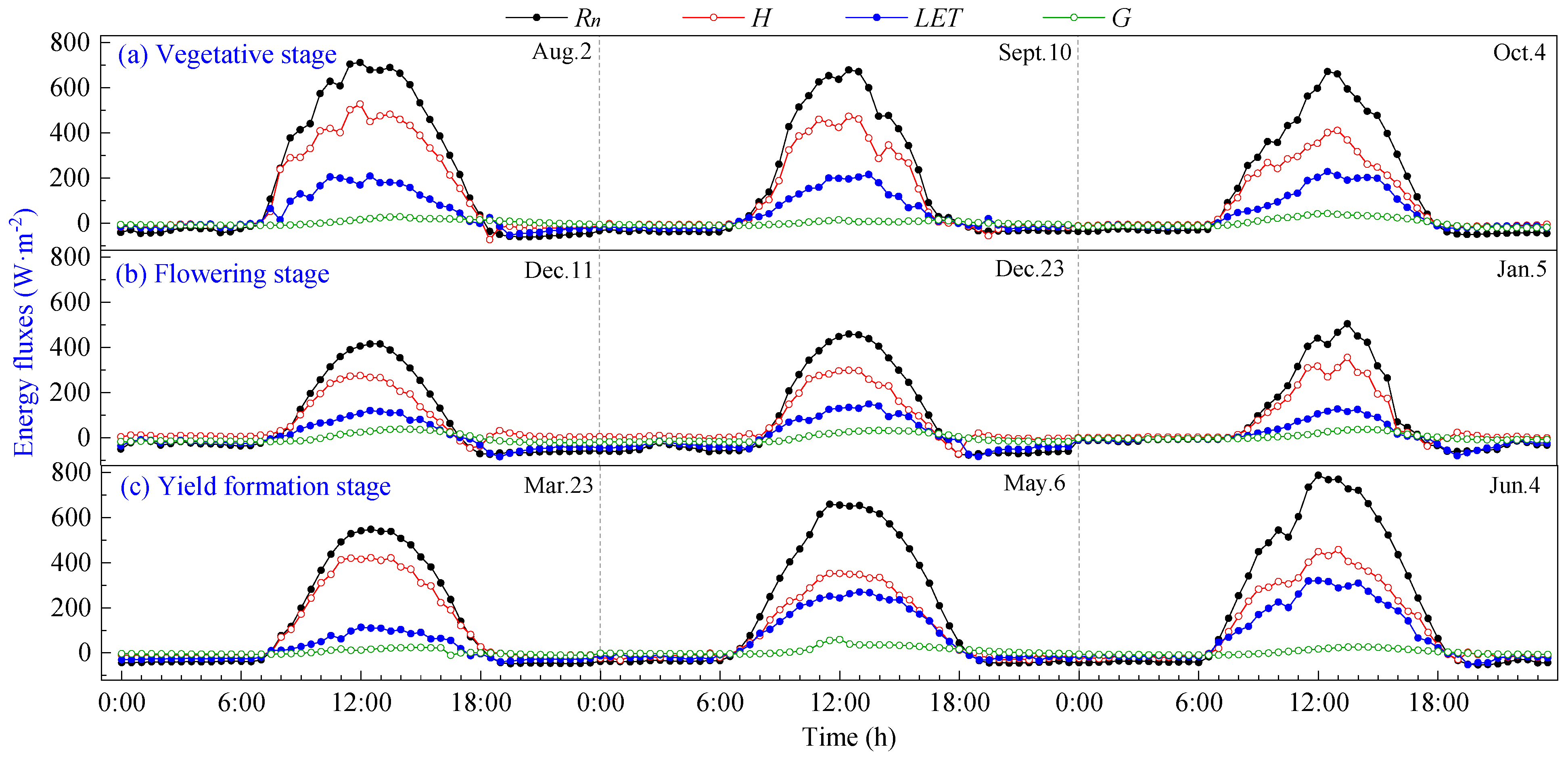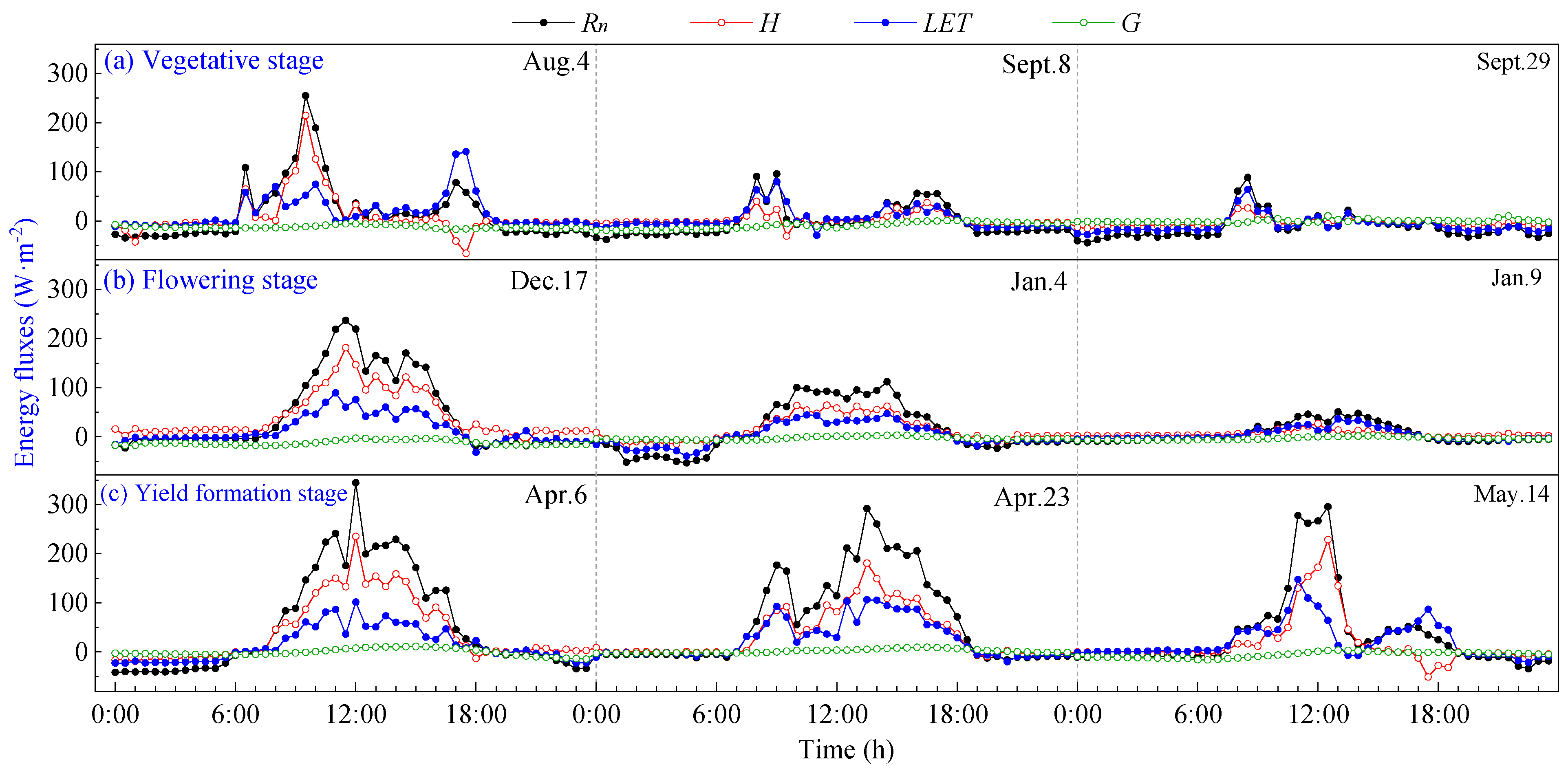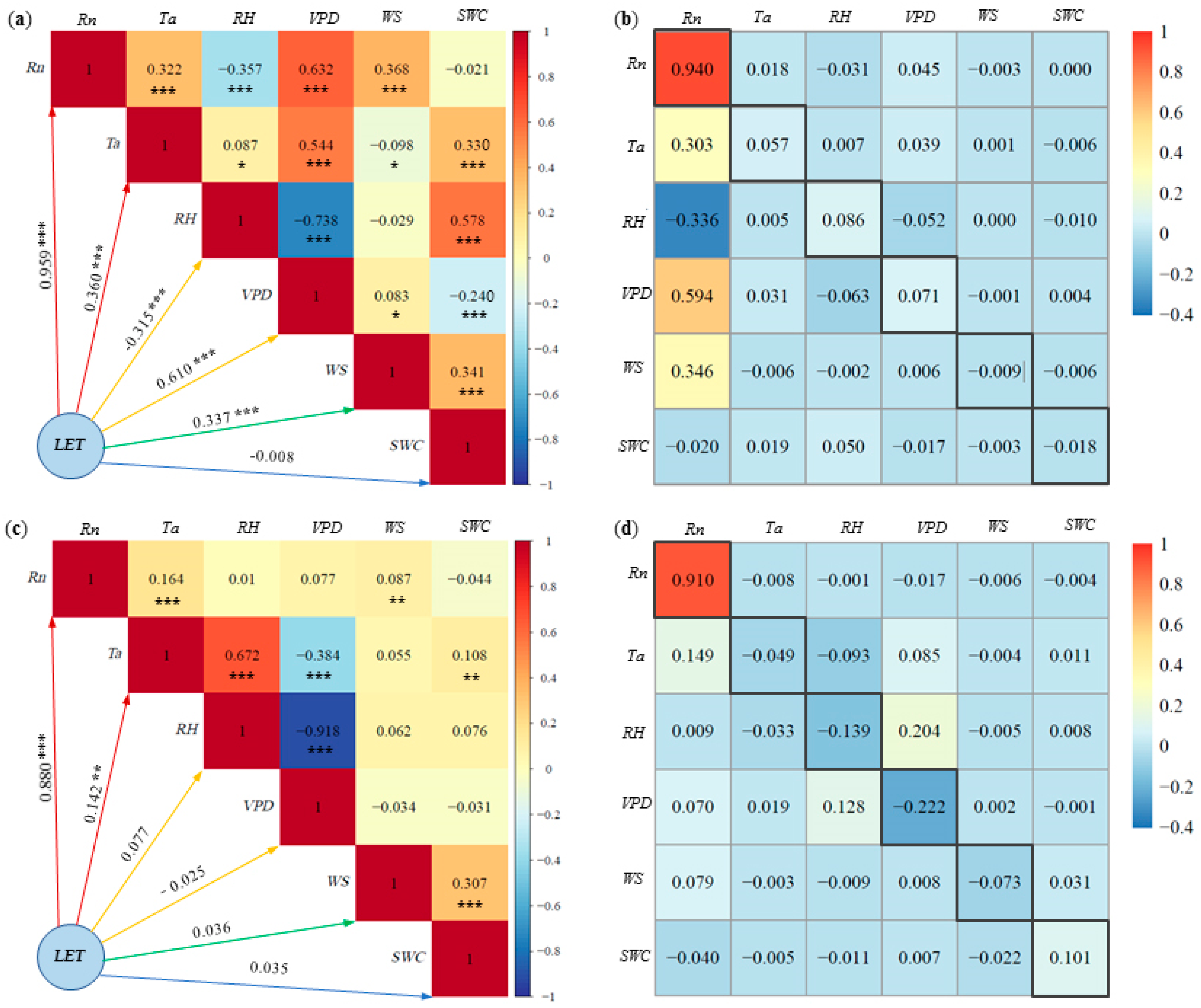Energy Partitioning and Latent Heat Flux Driving Factors of the CAM Plant Pineapple (Ananas comosus (L.) Merril) Grown in the South Subtropical China
Abstract
:1. Introduction
2. Materials and Methods
2.1. Study Site
2.2. Field Measurements
2.3. Data Processing
3. Results
3.1. Meteorological and Soil Moisture Conditions
3.2. Daily Variation of Energy Partitioning
3.3. Energy Partitioning of Pineapple Fields during Different Growth Periods
3.4. Diurnal Variation of Bowen Ratio
3.5. Driving Factors for LET
4. Discussion
4.1. Characteristics of Energy Partitioning
4.2. Effects of Environmental Factors on LET
5. Conclusions
Author Contributions
Funding
Data Availability Statement
Acknowledgments
Conflicts of Interest
References
- Eugster, W.; Rouse, W.R.; Sr, R.A.P.; Mcfadden, J.P.; Baldocchi, D.D.; Kittel, T.G.F.; Chapin, F.S.; Liston, G.E.; Vidale, P.L.; Vaganov, E.; et al. Land–atmosphere energy exchange in Arctic tundra and boreal forest: Available data and feedbacks to cli-mate. Glob. Chang. Biol. 2000, 6, 84–115. [Google Scholar] [CrossRef] [PubMed]
- Findell, K.L.; Centine, P.; Lintner, B.R.; Kerr, C. Probability of afternoon precipitation in eastern United States and Mexico enhanced by high evaporation. Nat. Geosci. 2011, 4, 434–439. [Google Scholar] [CrossRef]
- Duveiller, G.; Hooker, J.; Cescatti, A. The mark of vegetation change on Earth’s surface energy balance. Nat. Commun. 2018, 9, 679. [Google Scholar] [CrossRef] [PubMed]
- Yin, J.; Calabrese, S.; Daly, E.; Porporato, A. The energy side of Budyko: Surface energy partitioning from hydrological observations. Geophys. Res. Lett. 2019, 46, 7456–7463. [Google Scholar] [CrossRef]
- Wang, Y.; You, C.; Gao, Y.; Li, Y.; Niu, Y.; Shao, C.; Wang, X.; Xin, X.; Yu, G.; Han, X.; et al. Seasonal variations and drivers of energy fluxes and partitioning along an aridity gradient in temperate grasslands of Northern China. Agric. For. Meteorol. 2023, 342, 109736. [Google Scholar] [CrossRef]
- Li, L.; Bisht, G.; Leung, L.R. Spatial heterogeneity effects on land surface modeling of water and energy partitioning. Geosci. Model Dev. 2022, 15, 5489–5510. [Google Scholar] [CrossRef]
- Wu, D.; Li, G.; Zhang, X. Energy balance and closure of typical winter wheat farmland ecosystem in the North China Plain. Chin. J. Eco-Agric. 2017, 25, 1413–1422. [Google Scholar]
- Gao, X.; Mei, X.; Gu, F.; Hao, W.; Gong, D.; Li, H. Evapotranspiration partitioning and energy budget in a rainfed spring maize field on the Loess Plateau, China. Catena 2018, 166, 249–259. [Google Scholar] [CrossRef]
- Yan, H.; Deng, S.; Zhang, C.; Wang, G.; Zhao, S.; Li, M.; Liang, S.; Jiang, J.; Zhou, Y. Determination of energy partition of a cucumber grown Venlo-type greenhouse in southeast China. Agric. Water Manag. 2023, 276, 108047. [Google Scholar] [CrossRef]
- Feng, Y.; Gong, D.; Mei, X.; Hao, W.; Tang, D.; Cui, N. Energy balance and partitioning in partial plastic mulched and non-mulched maize fields on the Loess Plateau of China. Agric. Water Manag. 2017, 191, 193–206. [Google Scholar] [CrossRef]
- Gong, X.; Qiu, R.; Zhang, B.; Wang, S.; Ge, J.; Gao, S.; Yang, Z. Energy budget for tomato plants grown in a greenhouse in northern China. Agric. Water Manag. 2021, 255, 107039. [Google Scholar] [CrossRef]
- Perez, P.J.; Castellv, F.; Martı’nez-Cob, A. A simple model for estimating the Bowen ratio from climatic factors for determining latent and sensible heat flux. Agric. For. Meteorol. 2008, 148, 25–37. [Google Scholar] [CrossRef]
- Yan, H.; Zhang, C.; Gerrits, M.; Acquah, S.; Zhang, H.; Wu, H.; Zhao, B.; Huang, S.; Fu, H. Parametrization of aerodynamic and canopy resistances for modeling evapotranspiration of greenhouse cucumber. Agric. For. Meteorol. 2018, 262, 370–378. [Google Scholar] [CrossRef]
- Yan, H.; Li, M.; Zhang, C.; Zhang, J.; Wang, G.; Yu, J.; Ma, J.; Zhao, S. Comparison of evapotranspiration upscaling methods from instantaneous to daytime scale for tea and wheat in southeast China. Agric. Water Manag. 2022, 264, 107464. [Google Scholar] [CrossRef]
- Jian, J.; Du, X.; Reiter, M.S.; Stewart, R.D. A meta-analysis of global cropland soil carbon changes due to cover cropping. Soil Biol. Biochem. 2020, 143, 107735. [Google Scholar] [CrossRef]
- Li, C.; Wang, G.; Han, Q.; Sun, J.; Ning, H.; Feng, D. Soil moisture and water-nitrogen synergy dominate the change of soil carbon stock in farmland. Agric. Water Manag. 2023, 287, 108424. [Google Scholar] [CrossRef]
- Lu, J.; Zhang, W.; Li, Y.; Liu, S.; Aziz, K.; Yan, S.; Hu, T.; Xiong, Y. Effects of reduced tillage with stubble remaining and nitrogen application on soil aggregation, soil organic carbon and grain yield in maize-wheat rotation system. Eur. J. Agron. 2023, 149, 126920. [Google Scholar] [CrossRef]
- Alberto, M.C.R.; Wassmann, R.; Hirano, T.; Miyata, A.; Hatano, R.; Kumar, A.; Padre, A.; Amante, M. Comparisons of energy balance and evapotranspiration between flooded and aerobic rice fields in the Philippines. Agric. Water Manag. 2011, 98, 1417–1430. [Google Scholar] [CrossRef]
- Liu, X.; Xu, J.; Yang, S.; Lv, Y. Surface Energy Partitioning and Evaporative Fraction in a Water-Saving Irrigated Rice Field. Atmosphere 2019, 10, 51. [Google Scholar] [CrossRef]
- Silva Junior, A.C.d.; Souza, P.J.d.O.P.d.; Sousa, D.d.P.; Martorano, L.G.; Silva, C.M.d.; Silva, C.M.d.; Nunes, H.G.G.C.; Lima, M.J.A.d.; Sousa, A.M.L.d.; Pinto, J.V.d.N.; et al. Energy Balance, Water Demand, and Crop Coefficient of Acid Lime in the Oriental Amazon. Water 2023, 15, 1239. [Google Scholar] [CrossRef]
- Denis, d.P.S.; Thiago, F.S.F.; Lucas, B.T. Estimation of evapotranspiration and single and dual crop coefficients of acai palm in the Eastern Amazon (Brazil) using the Bowen ratio system. Irrig. Sci. 2021, 39, 5–22. [Google Scholar]
- Pedro, V.d.A.; Cleber, B.d.S.; Bernardo, B.d.S.; Vicente, P.R.d.S. Water requirements of pineapple crop grown in a tropical environment, Brazil. Agric. Water Manag. 2007, 88, 201–208. [Google Scholar]
- Zhang, Y.; Liu, C.; Yu, Q.; Shen, Y.; Kendy, E.; Kondoh, A.; Tang, C.; Sun, H. Energy fluxes and the Priestley-Taylor parameter over winter wheat and maize in the North China Plain. Hydrol. Process. 2010, 18, 2235–2246. [Google Scholar] [CrossRef]
- Margonis, A.; Papaioannou, G.; Kerkides, P.; Kitsara, G.; Bourazanis, G. Canopy Resistance and Actual Evapotranspiration over an Olive Orchard. Water Resour. Manag. 2018, 32, 5007–5026. [Google Scholar] [CrossRef]
- Han, Q.; Wang, T.; Dai, Y.; Kong, Z. Interactive impacts of atmospheric, soil, and vegetation conditions on land surface energy partitioning over a coastal wetland in Northern China. J. Hydrol. 2022, 614, 128506. [Google Scholar] [CrossRef]
- Kozak, M.; Kang, M.S. Note on modern path analysis in application to crop science. Commun. Biometry Crop Sci. 2006, 1, 32–34. [Google Scholar]
- Shao, W.; Wang, Q.; Guan, Q.; Luo, H.; Ma, Y.; Zhang, J. Distribution of soil available nutrients and their response to environ-mental factors based on path analysis model in arid and semi-arid area of northwest China. Sci. Total Environ. 2022, 827, 154254. [Google Scholar] [CrossRef]
- Zhang, X.; YAN, Y.; HU, Z. Using Path Analysis to Identify Impacting Factors of Evapotranspiration at Different Time Scales in Farmland. Chin. J. Agrometeorol. 2017, 38, 201–210. [Google Scholar]
- Pei, D.; Wei, X.; Bai, Y.; Wang, C.; Liu, Y.; Jiang, S. Path Analysis of the Main Control Factors of Transpiration in Greenhouse, Drip-Irrigated Grapes in Cold Areas of Northeast China. Water 2022, 14, 3764. [Google Scholar] [CrossRef]
- Gong, X.; Bo, G.; Liu, H.; Ge, J.; Li, X.; Gao, S. Performance of the Improved Priestley-Taylor Model for Simulating Evapotranspi-ration of Greenhouse Tomato at Different Growth Stages. Plants 2022, 11, 2956. [Google Scholar] [CrossRef]
- Yan, C.; An, D.; Liu, Y.; Dou, M. Research Progress on Fertigation Technology of Pineapple. Chin. J. Trop. Crops 2021, 42, 1777–1787. [Google Scholar]
- Zhao, B.; An, D.; Yan, C.; Yan, H.; Kong, R.; Su, J. Spatiotemporal variations of reference evapotranspiration and its climatic driving factors in Guangdong, a humid subtropical province of South China. Agronomy 2023, 13, 1446. [Google Scholar] [CrossRef]
- Virginia, M.R.; Melanie, D.G.H.; Nicolás, H.S.; Paula, A.L. Water status response of pineapple using destructive and nondestructive indicators and their relations in two contrasting seasons. J. Saudi Soc. Agric. Sci. 2020, 19, 538–547. [Google Scholar]
- Jardim, A.M.d.R.F.; Morais, J.E.F.d.; Souza, L.S.B.d.; Souza, C.A.A.d.; Araújo Júnior, G.d.N.; Alves, C.P.; Silva, G.Í.N.d.; Leite, R.M.C.; Moura, M.S.B.d.; de Lima, J.L.M.P.; et al. Monitoring Energy Balance, Turbulent Flux Partitioning, Evapotranspiration and Biophysical Parameters of Nopalea cochenillifera (Cactaceae) in the Brazilian Semi-Arid Environment. Plants 2023, 12, 2562. [Google Scholar] [CrossRef]
- Keller, P.; Lüttge, U. Photosynthetic light-use by three bromeliads originating from shaded sites (Ananas ananassoides, Ananas comosus cv. Panare) and exposed sites (Pitcairnia pruinosa) in the medium Orinoco basin, Venezuela. Biol. Plant. 2005, 49, 73–79. [Google Scholar]
- Li, Y.; Li, R.; Wu, X. Studies on Relationship Between Stomata and Cold Resistance of 3 Pineapple Cultivars. J. Anhui Agric. Sci. 2013, 41, 1–3. [Google Scholar]
- Ma, H.; Li, L.; Liu, S.; Shi, W.; Wang, C.; Zhao, Q.; Cui, N.; Wang, Y. Physiological response, phytohormone signaling, biomass production and water use efficiency of the CAM plant Ananas comosus under different water and nitrogen regimes. Agric. Water Manag. 2022, 266, 107563. [Google Scholar] [CrossRef]
- Zhao, B.; Dou, M.; An, D.; An, C.; Ma, H.; Huang, S.; Su, J. Characteristics of Dry-wet Climate Change and Its Impacts on the Yield of Rice, Sugarcane and Peanut in Zhanjiang Area, Guangdong, China. Chin. J. Trop. Crop. 2023, 44, 1506–1514. [Google Scholar]
- Bowen, I.S. The ratio of heat losses by conduction and by evaporation from any water surface. Phys. Rev. 1926, 27, 779–787. [Google Scholar] [CrossRef]
- Tanner, B.D.; Greene, J.P.; Bingham, G.E. A Bowen-Ratio Design for Long Term Measurements; ASAE Paper No. 87-2503; American Society of Agricultural and Biological Engineers: St. Joseph, MI, USA, 1987; pp. 1–6. [Google Scholar]
- Perez, P.J.; Castellvi, F.; Ibañez, M.; Rosell, J.I. Assessment of reliability of Bowen ratio method for partitioning fluxes. Agric. For. Meteorol. 1999, 97, 141–150. [Google Scholar] [CrossRef]
- Qiao, Y.; Zhang, B.; Qiu, K. Using Eddy Covariance Method to Analyze Energy Balance of Jujube Orchard in Arid Areas. J. Irrig. Drain. 2023, 42, 41–47. [Google Scholar]
- Jia, X.; Zha, T.; Gong, J.; Wu, B.; Zhang, Y.; Qin, S.; Chen, G.; Feng, W.; Kellomaki, S.; Peltola, H. Energy partitioning over a semi-arid shrubland in northern China. Hydrol. Process. 2016, 30, 972–985. [Google Scholar] [CrossRef]
- Jiao, L.; Ding, R.; Kang, S.; Du, T.; Tong, L.; Li, S. A comparison of energy partitioning and evapotranspiration over closed maize and sparse grapevine canopies in northwest China. Agric. Water Manag. 2018, 203, 251–260. [Google Scholar] [CrossRef]
- Zitouna-Chebbi, R.; Jacob, F.; Pr´evot, L.; Voltz, M. Documenting evapotranspiration and surface energy fluxes over rainfed annual crops within a Mediterranean hilly agrosystem. Agric. Water Manag. 2023, 277, 108117. [Google Scholar] [CrossRef]
- Liu, B.; Cui, Y.; Luo, Y.; Shi, Y.; Liu, M.; Liu, F. Energy partitioning and evapotranspiration over a rotated paddy field in Southern China. Agric. For. Meteorol. 2019, 276–277, 107626. [Google Scholar] [CrossRef]
- Pan, Y.; Xiao, H.; Xin, Z.; Li, J.; Miri, A.; Cao, Q. Characteristics of Energy Distribution in a Desert Ecosystem in Inner Mongolia, Northern China. Front. Environ. Sci. 2022, 10, 939782. [Google Scholar] [CrossRef]
- San-José, J.; Montes, R.; Nikonova, N. Diurnal patterns of carbon dioxide, water vapour, and energy fluxes in pineapple [Ananas comosus (L.) Merr. cv. Red Spanish] field using eddy covariance. Photosynthetica 2007, 45, 370–384. [Google Scholar]
- Gao, X.; Zhang, J.; Cai, J.; Pei, S.; Liu, L.; Meng, P.; Huang, H. Surface energy partitioning and evapotranspiration in a Pinus tabuliformis plantation in Northeast China. Front. Plant Sci. 2023, 14, 1048828. [Google Scholar] [CrossRef]
- You, Q.; Xue, X.; Peng, F.; Gao, Y. Surface water and heat exchange comparison between alpine meadow and bare land in a permafrost region of the Tibetan Plateau. Agric. For. Meteorol. 2017, 232, 48–65. [Google Scholar] [CrossRef]
- Qiu, R.; Yang, Z.; Jing, Y.; Liu, C.; Wang, Z. Analysis of water and heat flux over rice-wheat rotation field and influencing factors. Trans. Chin. Soc. Agric. Eng. 2018, 34, 82–88. [Google Scholar]
- Pan, Y.; Xiao, H.; Xin, Z. Characteristics of Energy Balance and Evapotranspiration of Sparse Shrubs in the Northeastem Edge of Ulan Buh Desert. Jounal Ecol. Rural. Environ. 2022, 38, 1447–1455. [Google Scholar]
- Qiu, R.; Liu, C.; Cui, N.; Wu, Y.; Wang, Z.; Lie, G. Evapotranspiration estimation using a modified Priestley-Taylor model in a rice-wheat rotation system. Agric. Water Manag. 2019, 224, 105755. [Google Scholar] [CrossRef]
- Yan, H.; Yu, J.; Zhang, C.; Wang, G.; Huang, S.; Ma, J. Comparison of two canopy resistance models to estimate evapotranspiration for tea and wheat in southeast China. Agric. Water Manag. 2020, 245, 106581. [Google Scholar] [CrossRef]
- Huang, S.; Yan, H.; Zhang, C.; Wang, G.; Acquah, S.J.; Yu, J.; Li, L.; Ma, J.; Opoku Darko, R. Modeling evapotranspiration for cucumber plants based on the Shuttleworth-Wallace model in a Venlo-type greenhouse. Agric. Water Manag. 2020, 228, 105861. [Google Scholar] [CrossRef]
- Li, S.; Eugster, W.; Asanuma, J.; Kotani, A.; Davaa, G.; Oyunbaatar, D.; Sugita, M. Energy partitioning and its biophysical controls above a grazing steppe in central Mongolia. Agric. For. Meteorol. 2006, 137, 89–106. [Google Scholar] [CrossRef]
- Aires, L.; Pio, C.A.; Pereira, J.S. The effect of drought on energy and water vapor exchange above a mediterranean C3/C4 grassland in Southern Portugal. Agric. For. Meteorol. 2008, 148, 565–579. [Google Scholar] [CrossRef]
- Krishnan, P.; Meyers, T.P.; Scott, R.L.; Kennedy, L.; Heuer, M. Energy exchange and evapotranspiration over two temperate semi-arid grasslands in North America. Agric. For. Meteorol. 2012, 153, 31–44. [Google Scholar] [CrossRef]
- Baldocchi, D.D.; Xu, L.; Kiang, N. How plant functional-type, weather, seasonal drought, and soil physical properties alter water and energy fluxes of an oak-grass savanna and an annual grassland. Agric. For. Meteorol. 2004, 123, 13–39. [Google Scholar] [CrossRef]
- Ford, T.W.; Wulff, C.O.; Quiring, S.M. Assessment of observed and model derived soil moisture-evaporative fraction relationships over the United States Southern Great Plains. J. Geophys. Res. Atmos. 2014, 119, 6279–6291. [Google Scholar] [CrossRef]







| Available Energy | Vapor Pressure Gradient | Bowen Ratio | Heat Fluxes |
|---|---|---|---|
| Rn − G > 0 | Δe > 0 | β > −1 | LET > 0 and H ≤ 0 for −1< β ≤ 0 or H > 0 for β > 0 |
| Δe < 0 | β < −1 | LET < 0 and H > 0 | |
| Rn − G > 0 | Δe > 0 | β < −1 | LET > 0 and H < 0 |
| Δe < 0 | β > −1 | LET < 0 and H ≥ 0 for −1 < β ≤ 0 or H < 0 for β > 0 |
| Growth Periods | Time Period | Sunny Days | Cloudy Days | ||||||
|---|---|---|---|---|---|---|---|---|---|
| Rn | H | LET | G | Rn | H | LET | G | ||
| Vegetative stage | 8:00–18:00 | 413.44 | 280.35 | 119.47 | 13.62 | 28.96 | 12.57 | 21.41 | −5.67 |
| 18:00–8:00 | −32.66 | −10.29 | −13.91 | −8.11 | −21.69 | −5.13 | −8.13 | −8.78 | |
| Flowering stage | 8:00–18:00 | 227.36 | 150.78 | 61.73 | 14.86 | 67.42 | 44.20 | 26.53 | −3.31 |
| 18:00–8:00 | −41.18 | 4.34 | −32.32 | −13.20 | −13.48 | 2.84 | −7.40 | −8.91 | |
| Yield formation stage | 8:00–18:00 | 431.33 | 265.70 | 149.52 | 16.11 | 134.14 | 77.56 | 53.77 | 2.75 |
| 18:00–8:00 | −32.39 | −10.33 | −17.68 | −4.38 | −12.52 | −2.52 | −5.00 | −5.20 | |
| Average | 8:00–18:00 | 357.38 | 232.28 | 110.24 | 14.86 | 76.84 | 44.78 | 33.91 | −2.07 |
| 18:00–8:00 | −35.41 | −5.43 | −21.30 | −8.56 | −15.90 | −1.61 | −6.84 | −7.63 | |
Disclaimer/Publisher’s Note: The statements, opinions and data contained in all publications are solely those of the individual author(s) and contributor(s) and not of MDPI and/or the editor(s). MDPI and/or the editor(s) disclaim responsibility for any injury to people or property resulting from any ideas, methods, instructions or products referred to in the content. |
© 2023 by the authors. Licensee MDPI, Basel, Switzerland. This article is an open access article distributed under the terms and conditions of the Creative Commons Attribution (CC BY) license (https://creativecommons.org/licenses/by/4.0/).
Share and Cite
Liu, Z.; Zhao, B.; Yan, H.; Su, J. Energy Partitioning and Latent Heat Flux Driving Factors of the CAM Plant Pineapple (Ananas comosus (L.) Merril) Grown in the South Subtropical China. Plants 2024, 13, 21. https://doi.org/10.3390/plants13010021
Liu Z, Zhao B, Yan H, Su J. Energy Partitioning and Latent Heat Flux Driving Factors of the CAM Plant Pineapple (Ananas comosus (L.) Merril) Grown in the South Subtropical China. Plants. 2024; 13(1):21. https://doi.org/10.3390/plants13010021
Chicago/Turabian StyleLiu, Zhigang, Baoshan Zhao, Haofang Yan, and Junbo Su. 2024. "Energy Partitioning and Latent Heat Flux Driving Factors of the CAM Plant Pineapple (Ananas comosus (L.) Merril) Grown in the South Subtropical China" Plants 13, no. 1: 21. https://doi.org/10.3390/plants13010021
APA StyleLiu, Z., Zhao, B., Yan, H., & Su, J. (2024). Energy Partitioning and Latent Heat Flux Driving Factors of the CAM Plant Pineapple (Ananas comosus (L.) Merril) Grown in the South Subtropical China. Plants, 13(1), 21. https://doi.org/10.3390/plants13010021











